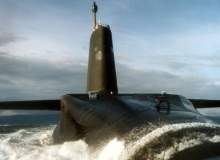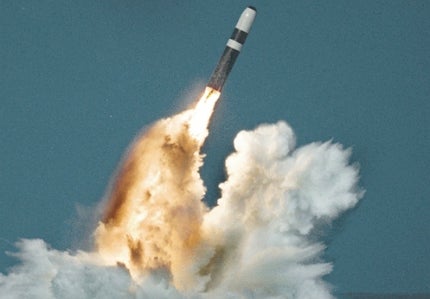

Major decisions to buy, upgrade or replace deterrence capabilities have generally occurred in periods of slow economic growth, for example Trident was approved during the downturn at the beginning of the 1980s, and it is still with us.
This begs the question, is our own economic downturn in the late-2000s and early-2010s enough to spark a major change in our nuclear weapon policy or even UK disarmament?
When Britain acquired its first submarine-based nuclear deterrent in 1963, those in power probably gave little thought to the controversy it would create 50 years later in 2013. That decision, made by Conservative Prime Minister Harold Macmillan, has created one of the most politically divisive questions of our time; do we really need nuclear weapons?
The choice to acquire the Polaris ballistic missile was relatively straightforward for Macmillan, especially when the Cold War reached boiling point with the Cuban Missile Crisis in 1962, but in 2013 keeping nuclear weapons is more difficult to justify. So if the UK’s ability to pay for nuclear weapons plays a reduced role in determining the renewal of Trident, what will actually influence the decision?
Britain as a world power
After the Second World War Britain still considered itself one of the great powers in the world and the jewel in the crown had to be a nuclear bomb. Ernest Bevin, Foreign Secretary in 1946, famously proclaimed: "We have got to get this thing over here whatever it costs…we have got to have [a] bloody Union Jack on top of it."
Six years later in October 1952 Britain became the third member of an exclusive international club when it exploded its first atomic bomb. The only other countries able to unleash this amount of destruction were the US and Soviet Union, who both successfully tested weapons in 1945 and 1949, respectively.
Operation Hurricane – the designation for the first British nuclear test – saw the detonation of a 25 kiloton bomb off the coast of Australia. It was to be the prelude to Britain’s first operational nuclear deterrent – the Blue Danube – carried as a free-fall bomb by V-bomber aircraft.
For many, this cemented Britain’s position as a world power, a small island able to stand up to the might of the Soviet Union all by itself. The sheer magnitude of resources, knowledge and technology required in the building of a nuclear weapon meant it was the ultimate prestige weapon. But unlike any other weapon system – past or present – there is no measure for its success, how after all do you measure the effect of deterrence?
Despite this, more countries have joined the club since and the prestige and international standing of being a nuclear-armed power remains strong. Britain has kept a nuclear arsenal which it still describes as the ‘corner-stone’ of its defence policy, even though the deterrent’s raison d’être – the Cold War – is over.
Britain’s current nuclear deterrent system is Trident, which became operational in 1994. Four nuclear-powered Vanguard-Class submarines carry the US-made Trident II D-5 nuclear ballistic missile and at least one submarine is always at sea, a policy known as the Continuous at-Sea Deterrent (CASD). It is now over halfway through its lifecycle and due for replacement in the next decade.
Polaris and the US ‘special relationship’
Before Trident the Royal Navy operated an almost identical model of deterrence. This time with the Polaris ballistic missile, also a system of US-made missiles carried by British-made submarines. This was Britain’s first submarine-based nuclear weapon system acquired in April 1963 under the Polaris Sales Agreement (PAS) signed by Harold Macmillan and US President John F. Kennedy.
Polaris was a state-of-the-art system giving Britain a new lease of life as a nuclear power after its V-bomber deterrence became out-dated in the face of Soviet air defence technology. Four Resolution-Class nuclear submarines; Resolution, Repulse, Renown and Revenge patrolled continuously for 28 years, from 1968 to 1996.
Only a few months before the PAS, Britain nearly lost its nuclear deterrent capabilities when the US cancelled Skybolt, an air-to-ground ballistic missile the UK Government had planned to use as its future deterrent.
The Polaris agreement, and subsequent programme, marked an unprecedented period of US-UK relations, not only on nuclear matters but foreign policy in general.
This was largely due to the Polaris programme – and Trident – relying heavily on US support and thus reducing the independence of the deterrence. As part of the 1963 PAS, the US would supply Britain with highly-classified technology, including the Polaris missile as well as the launch tubes and fire control system.
Responsibility for building the submarines and nuclear warheads was still in British hands. Resolution and Repulse were built by Vickers Shipbuilding in Burrow-in-Furness and Renown and Revenge were constructed by Cammell Laird and Co. in Birkenhead. The warheads would be manufactured and maintained by the Atomic Weapons Research Establishment.
No other country enjoys the privileged position of being able to share nuclear secrets with the US. The relationship was deemed to be so effective that in 1982 the PAS was modified to allow the sale of Trident nuclear missiles, bypassing any need to sign a new treaty between the two countries.
The fabric of the state
Ever since HMS Resolution set sail on its maiden voyage in 1968 Britain has never lacked a CASD capability. The idea of having a nuclear-armed submarine patrolling continuously is now deep in the fabric of both military strategic thinking and political life in Britain. A recent YouGov poll showed 61% of British adults would like to see Trident replaced, compared to just 24% who wanted to see it scrapped.
Prime Ministers often come to the job sceptical about the deterrent, or at the very least insouciant, yet they soon realise the importance of what they are dealing with. In his autobiography My Journey, Tony Blair summed up his view of nuclear weapons: "I thought giving it up too big a downgrading of our status as a nation, and in an uncertain world, too big a risk for our defence."
The at-sea nuclear deterrent has survived for 45 years – and if deterrent theory is to be believed it has kept the UK population alive for that long too – through economic crises, major wars and shifting international orders.
The ghosts of Harold Macmillan and his insistence 50 years ago to acquire the Polaris missile still hang over the decision to renew Trident today.
Much more important than considerations about expenditure is the effect the deterrent has had on our relationship with the US and our own standing in the world as a political power. The military advice, and ultimately the political decision to renew, will be mainly influenced by this.
So the question may not be ‘Will Britain renew Trident?’ but ‘Did Macmillan renew Trident in 1963?’
Related content
Deep impact: inside the UK’s new Successor-Class nuclear submarine
Detailed design work is underway on the UK Royal Navy’s next-generation nuclear-powered ballistic missile submarine.
Video feature: US Navy X-47B UCAS-D spreads its wings
After carrying out a number of shore-based trials, X-47B began ship-based demonstrations, starting with flight-deck taxiing in December 2012 on another Nimitz-Class nuclear powered aircraft carrier, the USS Harry S Truman.



.gif)

